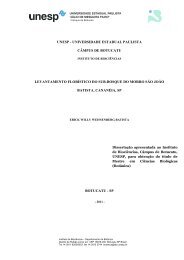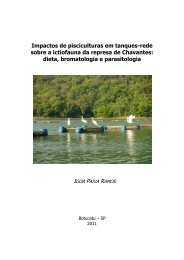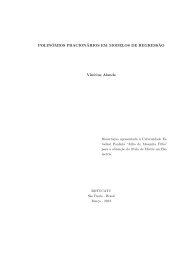Visualizar Tese - Instituto de Biociências - Unesp
Visualizar Tese - Instituto de Biociências - Unesp
Visualizar Tese - Instituto de Biociências - Unesp
Create successful ePaper yourself
Turn your PDF publications into a flip-book with our unique Google optimized e-Paper software.
André Mesquita Trombeta Dissertação <strong>de</strong> Mestrado 31<br />
Consi<strong>de</strong>rando-se que existe na região do pantanal cerca <strong>de</strong> 40 espécies <strong>de</strong><br />
anfíbios (Coutinho et al., 1997), que nesta região, apenas Rhinella schinei<strong>de</strong>ri (Catto,<br />
2001) teve sua endofauna parasitária estudada, e que apenas uma pequena parcela dos<br />
anfíbios brasileiros foram analisadas (Travassos et al., 1969; Vicente et al., 1990),<br />
torna-se necessário a realização <strong>de</strong> estudos para o conhecimento das relações parasitahospe<strong>de</strong>iro.<br />
OBJETIVOS<br />
O objetivo do presente estudo foi avaliar a helmintofauna <strong>de</strong> anfíbios das<br />
famílias Ceratophryiidae, Leptocatilidae e Leiuperidae proce<strong>de</strong>ntes da região do<br />
pantanal Sul, Estado <strong>de</strong> Mato Grosso do Sul, Brasil.<br />
MATERIAL E MÉTODOS<br />
Foram estudadas oito espécies da família Leptodactylidae, uma da família<br />
Ceratophryidae e três da família Leiuperidae, totalizando <strong>de</strong> 108 indivíduos, coletados<br />
entre <strong>de</strong>zembro <strong>de</strong> 2000 e março <strong>de</strong> 2006. Todos os animais incluídos no estudo<br />
estavam <strong>de</strong>positados na Coleção Zoológica <strong>de</strong> Referência, Seção <strong>de</strong> Herpetologia<br />
(CEUCH), da Universida<strong>de</strong> Fe<strong>de</strong>ral <strong>de</strong> Mato Grosso do Sul, Campus <strong>de</strong> Corumbá, MS.<br />
As espécies estudadas foram: família Ceratophryidae: Ceratophrys cranwelli<br />
(n = 3; CEUCH: NH 191, NH 193 e NH 495); família Leptodactylidae: Leptodactylus<br />
chaquensis (n = 6; CEUCH 1156, 2327, 1752, 3626, 3063 e 3624), Leptodactylus<br />
elenae (n = 15; CEUCH 1149, 1321, 1096, 2172, 1240, 1141, 978, 1504, 1401, 1048,<br />
1142, 1100, 2861, 2073 e 1061), Leptodactylus fuscus (n = 4; CEUCH 828, NH 665,<br />
1200 e 1202), Leptodactylus labyrinthicus (n = 7; CEUCH 3555, 1994, 3644, 2056,<br />
1338, 1675 e 1616), Leptodactylus mystacinus (n = 2; CEUCH 1515 e 853),<br />
Leptodactylus podicipinus (n = 13; CEUCH 2002, 1665, 3632, NH 698, NH 703, NH<br />
706, NH 708, 1087, NH 697, NH 699, NH 700, NH 705 e NH 707), Leptodactylus<br />
syphax (n = 7; CEUCH: 3557, 1268, 803, 1054, 1036, 1177 e 1148), Leptodactylus sp.<br />
(= A<strong>de</strong>nomera sp.) (n = 14; CEUCH 917, 1844, 1882, 1624, 1214, 1545, 1842, 1717,<br />
1855, 2088, 977, 1793, 1165 e 1134) e família Leiuperidae: Physalaemus albonotatus
















